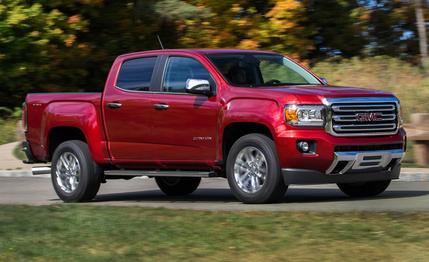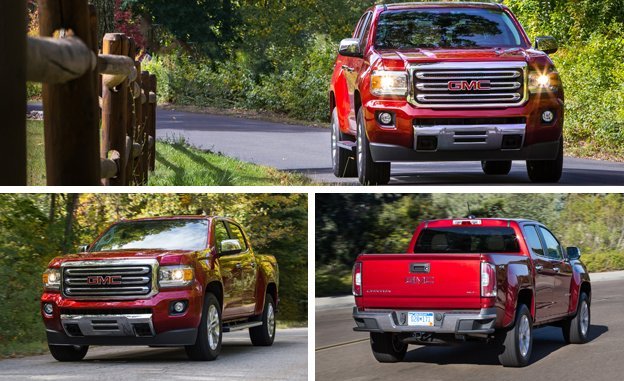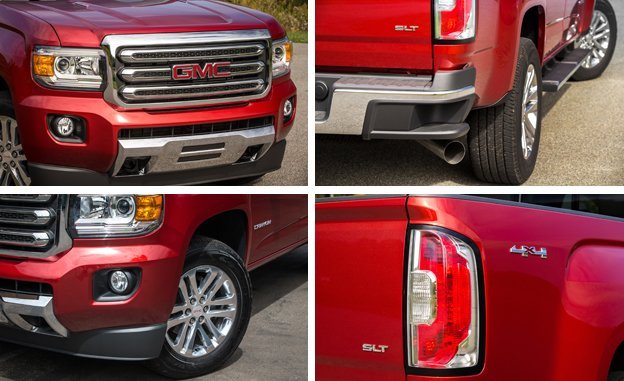
 First Drive Review
First Drive Review
Whether because of stubbornness, a true belief in the technology, or the fact that automotive product plans can’t easily be unraveled, General Motors is standing behind diesel despite the fuel type’s battered reputation of late. (Thanks, VW.) Indeed, the new Cruze once again will offer a diesel engine, Cadillac is moving forward with development of its own diesel powerplants, and—most pertinent to this review—the General’s new mid-size pickup trucks each offer a 2.8-liter Duramax four-cylinder diesel.
We’ve previously evaluated the Duramax Chevrolet Colorado and found it to be a satisfying entry in the recently reinvigorated mid-size pickup class, offering handy size, plenty of towing capacity—as much as 7700 pounds—and surprising refinement. All of that applies to this GMC Canyon, which is a mechanical twin to the Colorado.


The Thai-built 2.8-liter engine under the Canyon’s hood is rated for 181 horsepower and a meaty 369 lb-ft of torque, and it’s far more polished than you might expect a large-displacement, compression-ignition four-cylinder to be. GM’s diesel mid-size trucks employ all manner of noise- and vibration-mitigating measures meant to quell the typical diesel ruckus, including hydraulic engine mounts, counter-rotating balance shafts in the engine, a special vibration-absorbing damper inside the six-speed automatic’s torque converter, a dampening coating for the valve covers and oil pan, and extra sound-deadening materials in the cabin. It’s hard to tell you’re driving a diesel from inside the Canyon until you tip into the accelerator and feel the torquey step-off from a stop; even the typically gruff diesel sound has been relegated to a pleasant background noise.
The engine never feels taxed when driving around town, and the muscle available down low belies the estimated 10.2-second zero-to-60-mph time. Abundant torque means the transmission rarely has to busy itself looking for an appropriate gear—whichever one you’re in is the right one. And in case you’re wondering, this diesel engine is clean, according to the EPA. In the wake of the VW diesel-emissions cheating scandal, the government agency declared it would take a harder look at all diesel engines on the U.S. market, which may have had something to do with slightly delaying the Duramax Canyon’s arrival at dealerships. But the trucks are now available for purchase.
Pricing is a bit more ambitious than we’d like, as you have to spec the $30,010 Crew Cab in mid-level SLE trim to unlock the diesel option, which itself costs $4965 and also requires either the $395 Driver Alert package or the $1750 All-Terrain package, as well as the SLE Convenience package, an automatic locking rear differential, and the Trailering package. That means you’re in for 36 large to start. We’d like the diesel to be offered in the basic trim, or with the extended-cab body style, but it’s restricted to the SLE, SLT, and, as of the 2017 model year, the recently confirmed Denali trims, and it’s likely that you’ll be able to shoot well past $40,000 once you’ve fully kitted out your rig.
Some interior bits do look cheap, but the trimmings get nicer the further you climb up the ladder, and standard and available features include Apple CarPlay and Android Auto connectivity, forward-collision alert, lane-departure warning, 8.0-inch touchscreen infotainment, up to four USB ports, and a set of (quite comfortable) heated front seats. The Denali will come with heated and ventilated front seats, leather upholstery, a heated steering wheel, remote start, and a big infotainment screen with navigation.


In passenger cars, the primary selling point for diesel is big mileage, and that applies here with the 2WD version rated for an impressive 31 mpg on the highway, but most pickup buyers are more interested in a diesel engine’s torque and towing abilities, and GM says it made the latter a priority for this Canyon. The maximum tow rating, as mentioned, is 7700 pounds for rear-wheel-drive models, 7600 pounds for all-wheel-drive versions. An exhaust brake and an integrated trailer-brake controller are included to help the cause.
Mechanically, the diesel-engined Canyon is the same as the gas-powered versions excepting beefier front springs installed to handle the additional weight of the Duramax. (The diesel truck, GMC says, weighs about 250 pounds more than a commensurate V-6 gas model.) That means a driving experience similar to that of the Colorado LT 4x4 that recently won a head-to-head comparison test against the redesigned Toyota Tacoma, so it drives, well, like a small truck. The steering is numb and the ride a bit firm, but the primary controls are cohesive in operation, outward visibility is good, and the handling is decent. While the Canyon isn’t exactly small—it’s basically the same size as full-size trucks of a generation or two ago—the slightly pinched width and trimmed length make it more wieldy around town and on the freeway than most of today’s half-ton pickups.
GM expects something like 1 in 10 Canyon buyers to go Duramax; the other nine will be missing out—this satisfying truck affirms our own belief in diesel.